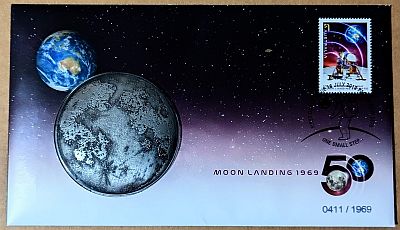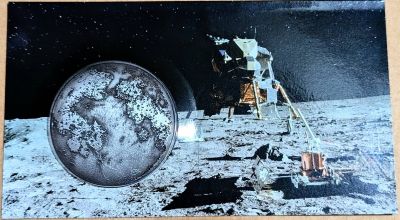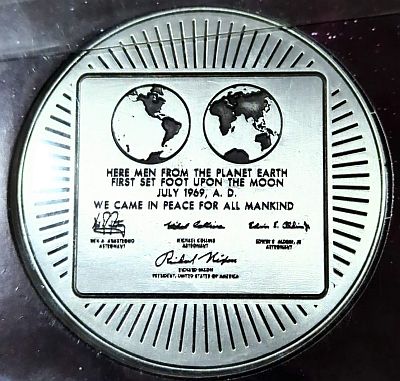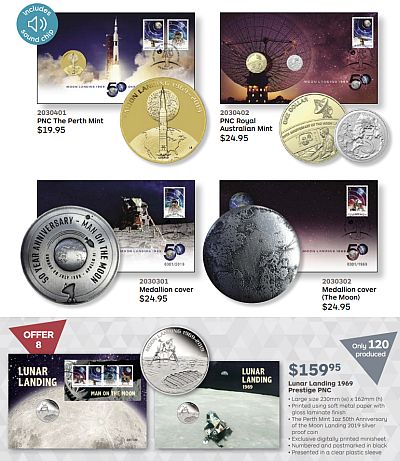A big medallion for a big milestone
July 20th, 2019 was the 50th anniversary of the Apollo 11 astronauts landing on the moon. This was the first time that humans had set foot on our nearest celestial neighbour. It also fulfilled the goal, uttered by US President Kennedy on May 25, 1961, that:
“I believe that this nation should commit itself to achieving the goal, before this decade is out, of landing a man on the moon and returning him safely to the earth. No single space project in this period will be more impressive to mankind, or more important for the long-range exploration of space; and none will be so difficult or expensive to accomplish.”
Obverse

The obverse highlights the medallion of the moon, with the Earth behind, in a starry background. The stamp showing the lunar lander is very prominent. There were 1,969 PMCs issued, of which this is number 0411.
The reverse of the PNC shows the black starry sky with a small moon in the top-right, and details about the event commemorated:
“MOON LANDING 50 YEARS
Fifty years ago, at 12.56 p.m: on 21 July 1969 (AEST), an estimated 600 million people worldwide watched American astronaut Neil Armstrong become the first person in history to step onto the surface of the Moon. As he alighted from lunar module Eagle, Armstrong uttered the now immortal words, “That’s one small step for (a) man; one giant leap for mankind”. Armstrong was accompanied in the Eagle by pilot Edwin “Buzz” “Aldrin, who joined him on the Moon’s surface some 20 minutes later, while Michael Collins piloted the command module Columbia in lunar orbit. After 21 hours 36 minutes on the lunar surface the lunar module docked with the orbiting command module and Armstrong and Aldrin returned to Columbia. Australia played a crucial role in telecasting the historic event to the world via NASA’s Honeysuckle Creek tracking station (ACT) and the Parkes radio telescope (NSW). The NASA tracking stations at Carnarvon (WA) and Tidbinbilla (ACT) also supported the mission.
Stamp and cover design: Gary Domoney, Visua
Stamp, cover and inner card photographs: NASA (lunar module Eagle, Moon surface), 1xpert/Adobe Stock (Earth); AGCuesta/Shutterstock (Moon)
RRP: $24.95″
Inner card

I often forget to pull out the inner card, but it almost always has another great image. In this case, the lunar lander on the surface.
Medallion Obverse

The obverse of the medallion depicts the surface of the moon. The medallion is curved which really makes the design pop.
From the details on the back of the inner card:
- Minimum Gross Weight (g): 63
- Maximum Diameter (mm): 60.00
- Maximum Thickness (mm): 5.00
- Metal Component: Zinc Alloy
Medallion reverse

The reverse of the medallion shows the plaque which the Apollo 11 astronauts left on the Moon in commemoration of the historic lunar landing mission. The plaque was attached to the ladder on the landing gear strut on the descent stage of the Apollo 11 Lunar Module (LM).
The plaque was covered with a thin sheet of stainless steel during flight. Astronaut Michael Collins, command module pilot, remained with the Command and Service Modules (CSM) in lunar orbit while astronauts Neil A. Armstrong, commander, and Edwin E. “Buzz” Aldrin Jr., lunar module pilot, explored the moon. The plaque says: “Here men from the planet Earth first set foot upon the moon, July 1969 A.D. We came in peace for all mankind.”
Stamp & Cancellation

The stamp shows the lunar lander on the moon with the earth in the background, and the value $1. The cancellation mark is dated First Day of Issue, 16th July 2019 – the 50th anniversary of the day the mission itself lifted off from Earth. It is postmarked at Parkes NSW 2870. Parkes is home to the radio telescope which broadcast the iconic TV pictures to the world:
In July 1969, the Parkes Observatory played an important role in history, when it received and broadcast the first Moon landing, Apollo 11. CSIRO’s Parkes radio telescope received television signals that allowed six hundred million people, one fifth of humanity at the time, to watch the broadcast.
Parkes was one of three tracking stations that received the broadcast. A NASA facility at Honeysuckle Creek transmitted the first eight and a half minutes before NASA decided Parkes’ feed was better quality and began transmitting it instead.
It was not plain sailing. While fully tipped over waiting for the Moon to rise, the Parkes telescope was struck by a series of severe, 110 km per hour gusts of wind, which made the control room shudder. The telescope was slammed back against its zenith axis gears, a dangerous situation that threatened the integrity of the telescope structure. Fortunately, the winds abated and Buzz Aldrin activated the TV camera just as the Moon rose into the telescope’s field of view. The Parkes radio telescope began tracking.
A selection of commemoratives
There were, of course, many commemoratives issued for the 50th anniversary of the first moon landing. This PNC was one of five issued by Australia post in 2019:
- A Royal Australia Mint PNC with $1 and 5c coins
- A PNC with Perth Mint dollar coin and sound chip
- A “Man on the Moon” medallion cover
- This “Moon” medallion cover
- A limited edition (120 issued) “Impressions” PNC featuring a 1oz silver Perth Mint coin

Images of the five PNCs taken from Stamp Bulletin 360, and Impressions 2019 booklet. There were also a number of ANDA show issues.


Leave a Reply